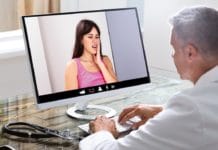Do you clench or grind your teeth? Wake up with headaches or stiff, tight muscles in your face? So many people are affected by the daily stress of life which can lead to clenching and grinding. Improper occlusion or airway issues can lead to bruxism and TMJ issues. Too much caffeine or too much gum chewing can lead to muscle imbalances or bulked-up masseter muscles which then can result in TMJ pain and aching, flattened teeth as well. It has been reported 25% of the population is affected with some jaw joint issue and 90% of those are women.
What options do you offer patients with headaches and TMJ issues? It seems our go-to has always been a bruxism appliance. These can be costly and are totally dependent on patient compliance. We all know compliance is hit or miss; many patients take them out consciously or unconsciously at night, pets may get at them, they get lost in a drawer, forgotten, or cause excessive drooling and discomfort. Night time appliances can decrease tooth wear, but do not decrease the muscle impact. Other options for treatment can be anti-inflammatories, moist heat packs, ice packs, ultrasound treatments, laser therapy directly to the muscles affected, and transcutaneous electrical nerve stimulation. However, we now know that Botox injections directly into the firing muscles reduce the muscle action and reduce headaches, migraines, and clenching/bruxing.
What do you tell your patients when you do the head and neck examination? We all learned to check the temporal-mandibular joint; having the patient open and close several times, and then open slightly and slide side to side. At this point you can feel any irregularities in the joint, perhaps, popping, clicking, crepitus, or deviations. This is a great time to discuss habits; gum chewing, nail biting, teeth clenching, nightly grinding, pain, difficulty opening or closing, and the duration of time this has been ongoing, as well as history or injury.
A quick muscle review may help with the examination. The masseter muscle runs vertically from cheekbones to the bottom of the jaw. These muscles very often are easy to palpate as you have the patient open and close, then chew up and down. In many, the muscle gets so much use from grinding, clenching, and parafunctional occlusal habits, it bulks-up and makes the face appear square. Those muscles should be soft and only slightly flexed when the patient simulates chewing, and no discomfort should be felt in the joint.
The temporalis muscle is located at the sides of the face, above the ears, in a large fan-shaped direction. Many of our patients will complain of recurrent headaches in this area or muscle soreness. The medial pterygoid muscles lay beneath and farther back than the masseter. These three muscles create the closing of the jaw and can become overstimulated from clenching and bruxing causing pain, headaches, and damage to the teeth and periodontium.
Botox injections are an excellent treatment option when muscles are involved. Botulinum toxin is used to reduce the strength of the muscles where injected. It can be used both cosmetically and therapeutically. In April of 2002, FDA approval was given for cosmetic use, and in February of 2011, approval for the treatment of chronic migraines was given.
Botox used for therapeutic application takes approximately four weeks to take complete effect. Muscles must be treated bilaterally, and studies show, starting with lower doses of Botox and offering enhancements as needed to get to the patients’ therapeutic dose, may be best. Others choose the approach of starting with a high dose and weaning back at subsequent sessions.
These treatments last longer than traditional cosmetic treatment; most often the first treatment lasting 4-6 months. Each subsequent treatment has been shown to last longer, with some patients ultimately relearning appropriate habits and weaning off Botox entirely. It should be noted, those weaned off Botox may experience periods of increased stress or trauma, and begin the destructive habit again to the point that retreatment may be necessary. Relaxing the muscles, especially in the masseter, causes atrophy or de-bulking of the muscle, which is why a softening of the facial muscles occurs, and the jawline becomes less square.
Post-injection instructions are minimal; avoid anti-inflammatory or blood thinning medications, along with herbal supplements, for a week before treatment to reduce the chances of bruising. Do not manipulate the muscles for 4 hours, including massaging, to ensure the Botox remains in the targeted site. Eating immediately after treatment is fine, with absolutely no dietary restrictions. Request the patient return in one month if an enhancement treatment of additional Botox is needed, or ask the patient to call and report the results.
Personally, I tried Botox treatments, as traditional methods were not giving me relief. Night guards were not an option, as I had tried several, and found I could not tolerate them. I tried laboratory fabricated, as well as over-the-counter brands, and gave up after five attempts. Anti-inflammatories work well, but who wants to take daily medication to reduce the tension in the muscle and have potential side effects? Exercises, moist heat packs, ice applications, and massage, were not cutting the tension, and my face shape was squarer; almost appearing as if I had gained weight.
Seven days after injection of 20 units in each masseter and five units in the medial pterygoid, I began to feel a tingle in the muscle. At 13 days my face was noticeably smoother, and I went through the night without clenching. By day, I could tell I was no longer clenching, and my teeth were apart at rest. At 17 days, I had more tingling in the muscle, but no headaches in the morning, and minimal clenching at night. By day, I was completely aware of any time I tried to clench. Interesting to note, my masseter muscles fatigue easier; if I eat chewy, crusty bread, I can feel it requires more effort. To date, this has not been enough to be a diet aid, but I imagine for meat-eaters, a large steak would require quite an effort to get through! While I do have some mild moments of night clenching, still after 5 ½ weeks, it immediately wakes me, and I can change sleep position then return to sleep, waking well-rested.
Botox treatments are becoming an absolute game-changer in the world of therapeutic treatment. At this time, dental hygienists cannot administer the injections, but we can offer the information to all our patients, along with the treatments you have traditionally found helpful. Know that Botox offers the patients a true treatment which enables the muscles to relax enough over time to relearn appropriate function. You may be the clinician that changes a patient’s life; reducing headaches, increasing sleep, and saving the dentition and periodontium from further damage, allowing the patient some peace.
Remember, Botox isn’t just for wrinkles anymore.
SEE ALSO: How Appropriate is Botox in the Dental Office?
DON’T MISS: True Confession of a Less than Ideal Bitewing















